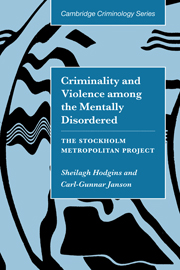Book contents
- Frontmatter
- Contents
- List of figures
- List of tables
- Preface
- Introduction
- Chapter 1 Research on the criminality and violence of the mentally ill
- Chapter 2 The longitudinal approach
- Chapter 3 Swedish society and Stockholm: the cohort and its context
- Chapter 4 Criminality
- Chapter 5 Explanations of the criminality of the mentally ill
- Chapter 6 Early and late-starters
- Chapter 7 Conclusion
- References
- Index
Chapter 1 - Research on the criminality and violence of the mentally ill
Published online by Cambridge University Press: 22 September 2009
- Frontmatter
- Contents
- List of figures
- List of tables
- Preface
- Introduction
- Chapter 1 Research on the criminality and violence of the mentally ill
- Chapter 2 The longitudinal approach
- Chapter 3 Swedish society and Stockholm: the cohort and its context
- Chapter 4 Criminality
- Chapter 5 Explanations of the criminality of the mentally ill
- Chapter 6 Early and late-starters
- Chapter 7 Conclusion
- References
- Index
Summary
Scientists contribute to resolving the social problem of crime committed by mentally disordered persons in two very different ways. One, they conduct applied research designed to contribute information useful for amending laws and providing services for mentally ill offenders. Two, scientists pursue more basic research on the causes of violence among persons with major mental disorders. The research described in this book falls within the second category, but, as will be seen, it provides much useful information for those who are responsible for the planning and organisation of services for persons with major mental disorders, for developing effective treatment programmes and management strategies, and for creating legal dispositions which prevent crime and violence in this population in the most humane manner possible.
APPLIED RESEARCH ON MAJOR MENTAL DISORDERS AND CRIMES
Applied research in this field is dominated by studies designed to improve the accuracy of assessing the risk of violent behaviour. These studies identify the characteristics of patients and their environments that are associated with violent behaviour in the future. They are conducted in clinical settings, with clinicians, and result in constant refinement of the procedures used to assess risk, improvements in the accuracy of these predicitions, and more appropriate clinical and legal decisions about the placement and disposition of mentally ill offenders. Accurate selection of those who are likely to behave in an illegal or violent manner prevents abuses of the rights of those who are unlikely to hurt others.
- Type
- Chapter
- Information
- Criminality and Violence among the Mentally DisorderedThe Stockholm Metropolitan Project, pp. 6 - 28Publisher: Cambridge University PressPrint publication year: 2002

